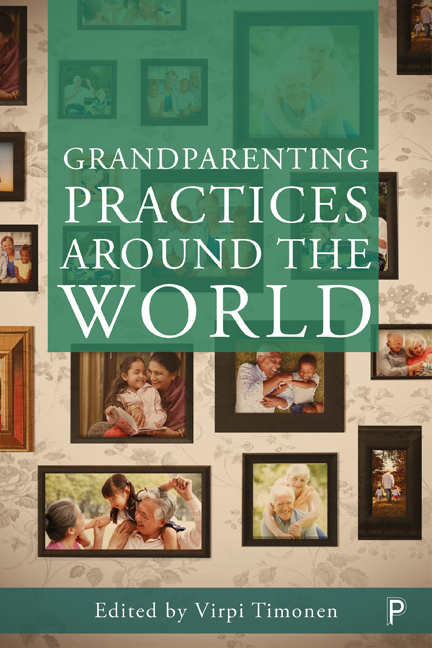Book contents
- Frontmatter
- Contents
- List of figures and tables
- List of abbreviations
- Notes on contributors
- one Introduction: widening the lens on grandparenting
- PART 1 The demographic and welfare-state contexts of grandparenting
- PART 2 Grandparenting in contexts of economic and societal development
- PART 3 Transnational grandparenting
- PART 4 Gender, intersectionalities and grandparenting
- PART 5 Grandparental roles, agency and influence
- Index
four - Grandparenting in developing South East Asia: comparative perspectives from Myanmar, Thailand and Vietnam
Published online by Cambridge University Press: 22 April 2022
- Frontmatter
- Contents
- List of figures and tables
- List of abbreviations
- Notes on contributors
- one Introduction: widening the lens on grandparenting
- PART 1 The demographic and welfare-state contexts of grandparenting
- PART 2 Grandparenting in contexts of economic and societal development
- PART 3 Transnational grandparenting
- PART 4 Gender, intersectionalities and grandparenting
- PART 5 Grandparental roles, agency and influence
- Index
Summary
Introduction
The extent, nature and consequences of grandparenting are profoundly shaped by social contexts and how these contexts change over time (Arber and Timonen, 2012; Hermalin et al., 1998). For instance, grandparental care in the United States is often prompted by problematic situations (for instance, death or incarceration of the grandchild's parent) that require grandparents to step in and provide care for grandchildren. By contrast, grandparenting in China is considered a normative part of reciprocal intergenerational exchanges. Thus, analyses of grandparental care across different settings can broaden our understanding of how social contexts affect grandparenting. A few exceptions notwithstanding (such as Baker and Silverstein, 2012), comparative studies of grandparental care remain relatively sparse. Among the few existing studies, there is a tendency to focus on cultural factors, thus often dismissing the roles of economic development and demographic trends in explaining cross-country differences in grandparental care.
To address these pertinent research gaps, this study examines the prevalence, correlates and older persons’ perceptions about grandparental care in Myanmar, Vietnam and Thailand. A combination of similarities and differences, especially in recent demographic histories and economic development levels that characterise these three South East Asian countries, make them suitable for comparative analyses of grandparenting. Importantly, ongoing debates concerning how development impacts on intergenerational relations add further interest to the cross-country comparisons (Aboderin, 2004; Hermalin, 2002; Knodel, 2014); for example, whether it will increase or decrease solidarity between generations.
Based on recent nationally representative surveys of older persons in the three countries, our analyses begin by describing trends in living arrangements among older persons. We specifically focus on the prevalence of older persons living with co-resident grandchildren. Additionally, we explore the extent to which skip-generation households (that is, households with only grandparents and grandchildren) prevail in the three countries. Furthermore, we address the extent and patterns of grandparental care. In particular, we consider variations of care provision by age of grandchildren and by presence of their parents. Using multivariate analyses, we examine the correlates of older persons providing care for grandchildren with and without the presence of the grandchild's parents in the household. Finally, to understand older persons’ perceptions of grandparental care, we examine the extent to which grandparents caring for grandchildren in these countries perceive care provision as burdensome.
- Type
- Chapter
- Information
- Grandparenting Practices around the World , pp. 65 - 88Publisher: Bristol University PressPrint publication year: 2018

